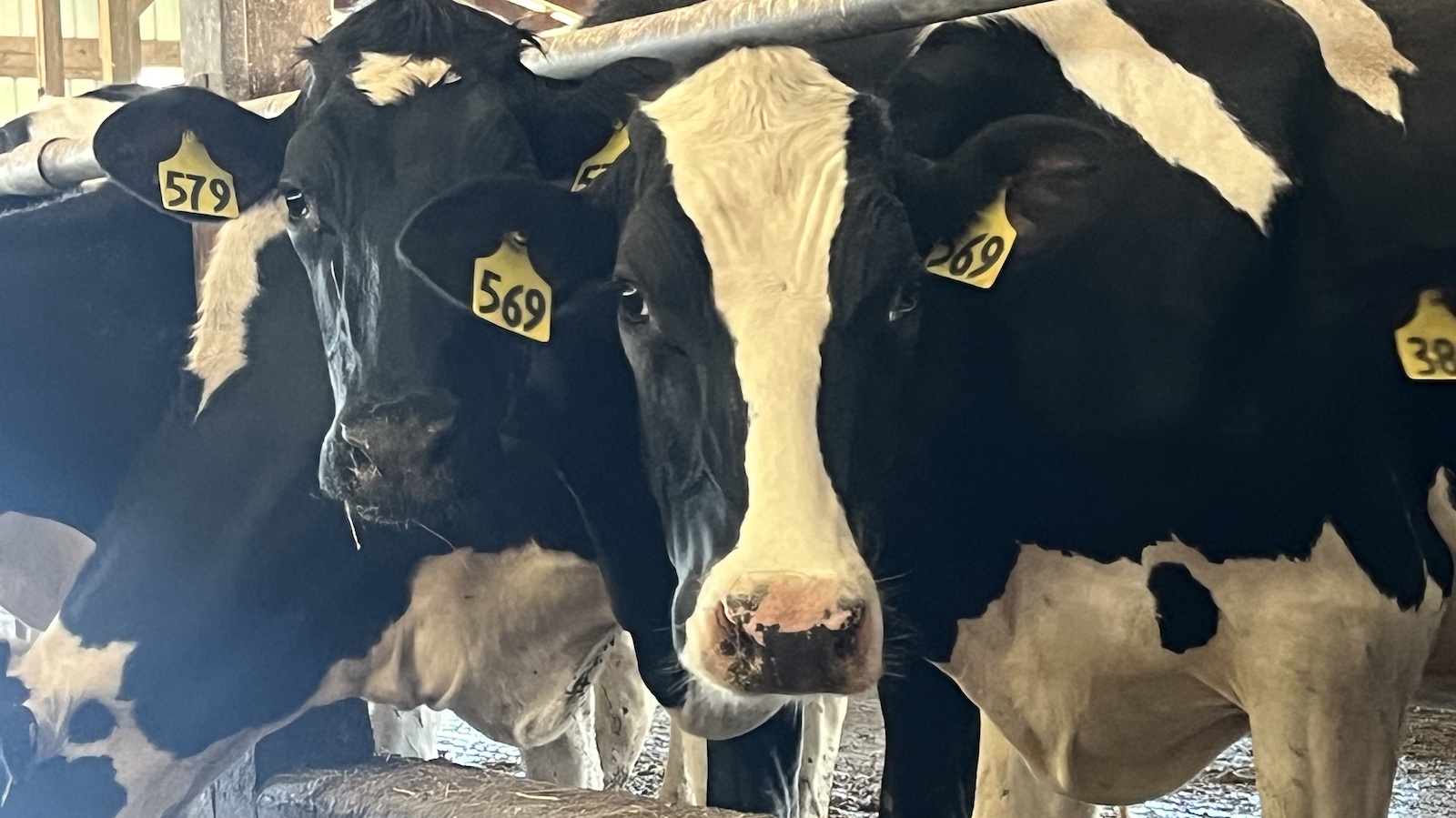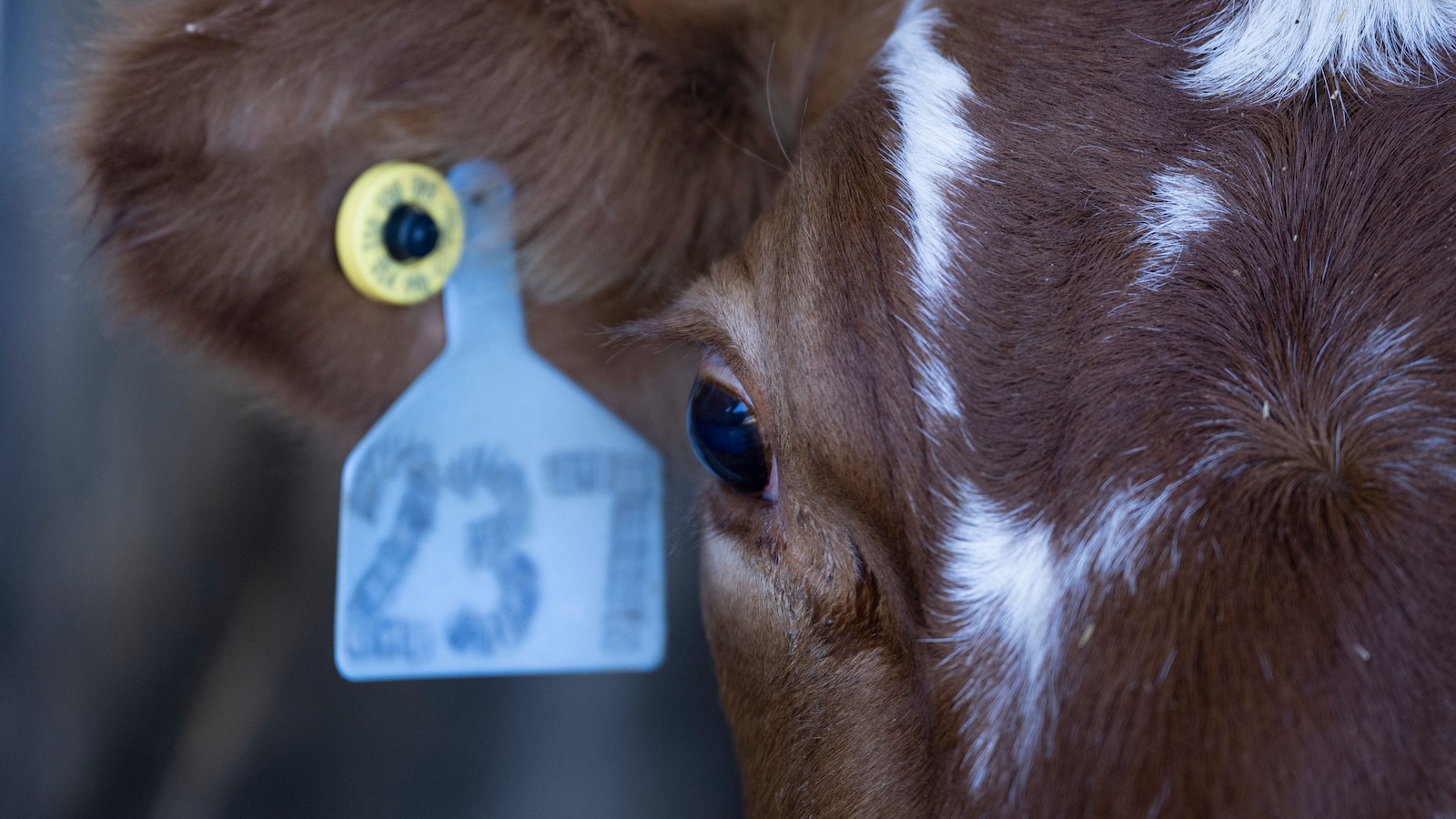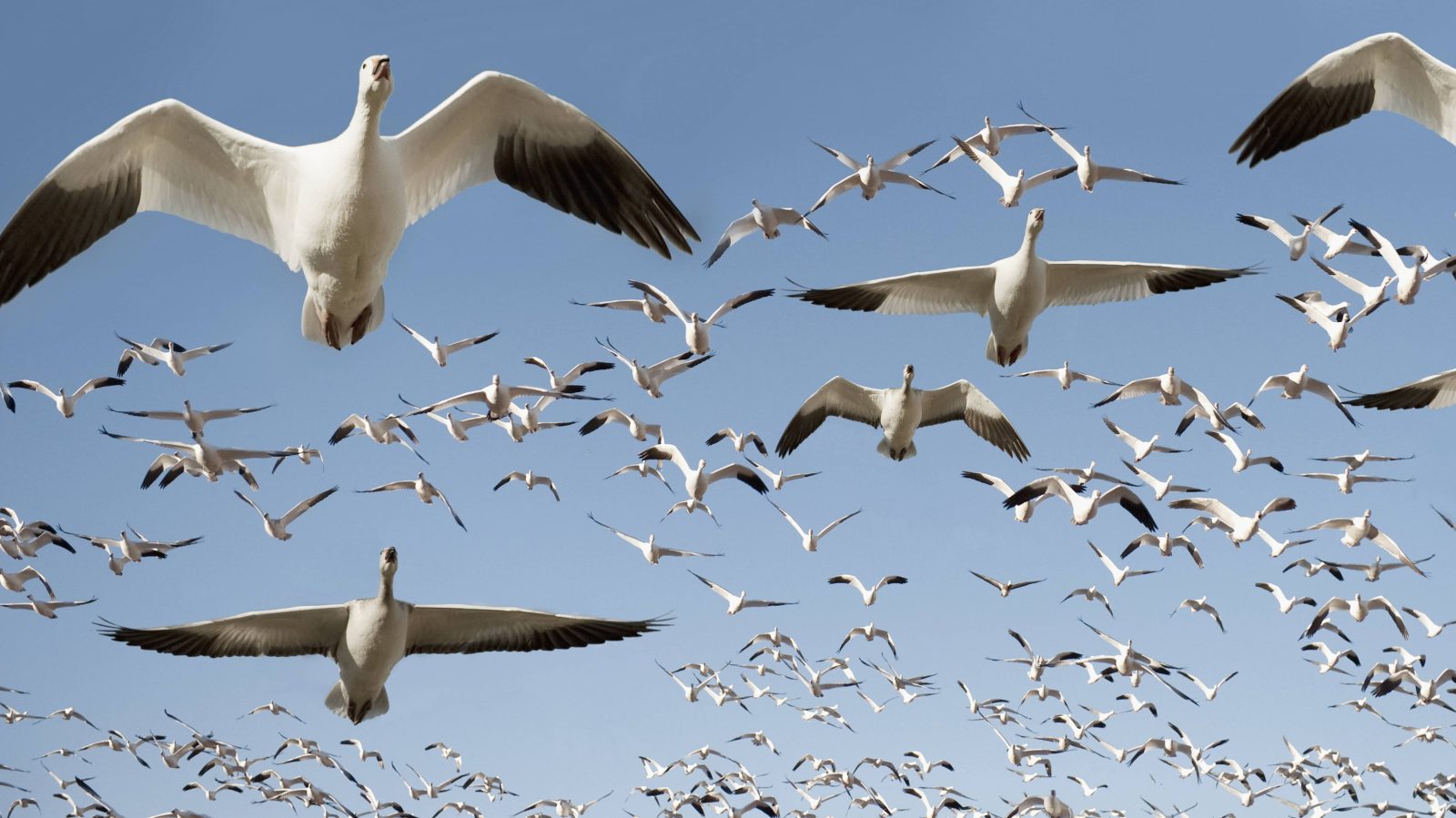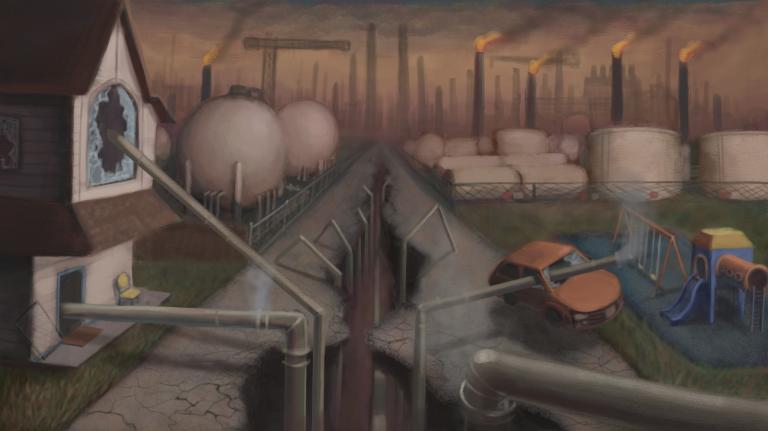This coverage is made possible through a partnership between IPR and Grist, a nonprofit environmental media organization.
Earlier this month, Laurie Stanek shoveled hay to a group of young black-and-white Holstein cows, just a few among the roughly 200 cattle on her family dairy farm. Located in northern Michigan’s Antrim County, she has worked there for almost 50 years now.
The farm day starts early.
“We’re out here at 5 o’clock every morning to get started feeding the babies,” she said.
But there are some additional chores for farmers in Michigan, now that avian influenza, or bird flu, has made the jump to cattle.
New state requirements include limiting the number of visitors and increasing disinfection practices like cleaning boots and vehicles. Michigan also has prohibited poultry or lactating cows from being shown at events like fairs. The U.S. Department of Agriculture has required that lactating cows moving across state lines receive a negative test result on bird flu.
“We are conscious that the threat is there, and we wouldn’t let just anybody come in,” Stanek said, referring to the state requirement to limit visitors.
With outbreaks of bird flu in dairy cattle across the country, health officials are emphasizing biosecurity — that is, efforts to prevent the introduction and spread of disease.
Researchers are still working to understand how climate change is affecting the spread of the bird flu. But, as Grist has previously reported, H5N1 has spread outside its typical seasons as migratory patterns have changed. And research has shown that generally, climate change could join a host of other factors in making the transmission of viruses between species more likely — something called “viral spillover.”
“We are in a place where the threat of emerging pathogens is much greater than ever before. So therefore, the need for biosecurity is even more significant than it has ever been before,” said Suresh Kuchipudi, a professor and chair of the infectious diseases and microbiology department at the University of Pittsburgh’s School of Public Health.
Some, like Kuchipudi, say scaling up biosecurity operations can help the agricultural sector become more resilient to climate change. But it’s just one part of the complicated process of responding to the spread of viruses like the bird flu.
This strain of avian influenza is called H5N1, and it’s highly pathogenic, meaning it’s deadly for poultry. First detected in the 1990s, it has surged over the last several years, spreading to birds and mammals across the world.
The spread to cattle is new.
“I’m a virologist by training, and my other virologist buddies and I all have to admit: None of us saw this coming,” said Kim Dodd, the director of the Veterinary Diagnostic Laboratory at Michigan State University. Animals like foxes can contract the flu when they eat an infected carcass. But cattle don’t eat meat.
“We didn’t expect to find [highly pathogenic] avian influenza in dairy cattle, and to find that it amplifies so well, and that we have so much virus in the milk,” Dodd said. “And so that’s really a big part of trying to understand, you know, what do we do about that to be able to help control the outbreak.”
The first confirmed case in cattle was reported in Texas earlier this year, and 11 more states have confirmed cases of the bird flu in dairy herds.
Michigan has reported the most cases in the country. As of Wednesday, the state had confirmed 25 instances of the flu in herds. It also has 2 of the 3 confirmed cases of the disease in people — the other was a dairy worker in Texas.
In May, state officials declared the flu an “extraordinary emergency,” calling it a threat to animal health, human health, trade and the economy.
Officials and researchers have said Michigan’s high case count is an example of robust testing in response to the outbreak. Overall, the response to the bird flu outbreak in cattle has been somewhat rocky. States have pushed back against federal efforts to address the virus, and public health experts have raised concerns about the lack of testing and warned that the true reach is likely greater that official counts.
Those involved in Michigan’s response have said part of its response is collaboration with farmers. “That takes two sides,” said Dodd. “It takes the people who are looking and the people who are testing, but it also requires that the people who own the animals are opening their doors and allowing testing to occur.”
H5N1 causes a reduction in cows’ milk production, among other symptoms. It can devastate the poultry industry; since it was detected in commercial flocks in the United States in 2022, it has led to the deaths of close to 100 million farmed birds.
The Centers for Disease Control and Prevention have maintained that the danger to the public is relatively low. But dairy workers are now more at risk of exposure to the bird flu as they work with cows; the virus appears to be spreading largely through milk.
“We want to make sure that we’re limiting the further spread of the virus, so that we’re continuing to protect human health, and we don’t have so much virus in the environment that could potentially mutate and affect humans in a different way,” said Tim Boring, the director of the state Department of Agriculture and Rural Development.
One of the ways the state is doing that is by urging farms to follow biosecurity measures. These are pretty low tech — like wearing protective gear and disinfecting equipment. How effective they are comes down to compliance.
“I’m sure they’re serious. I’m sure they’re not fooling around. It’s their livelihood, their investments,” said Jean-Pierre Vaillancourt, a professor of veterinary medicine at the University of Montreal. But “if they’re not sharing data, and they’re not doing good surveillance to figure out who’s where and what and all that, we already have a big problem.”
Climate change coincides with the spread of certain diseases, as animals interact with one another in new settings. While biosecurity may play a role in prevention or response, it likely won’t stop the next pandemic, Vaillancourt said. He argues that we should actually be looking at disease from a regional perspective.
“What can we do to minimize the spread between sites?” he said. “That requires data sharing.”
That’s where industry and institutions often fall short. Farms that have outbreaks can face stigma and lose money, and farm workers that test positive can deal with health and economic issues. Worker advocacy groups have also voiced concerns that testing isn’t reaching those on the front lines.
Some public health experts say the surge of bird flu in cattle is an opportunity to hone that response and protect animal and human life in the process.
“The fact is, [governments] need to learn how to get this right when the stakes are lower, because there are less forgiving bird flu viruses than this one,” said Amesh Adalja, a scholar at Johns Hopkins Center for Health Security.
The agricultural industry will have to be part of any response to infectious diseases as the climate changes. Humans often interact with animals in agricultural settings. Preventing and responding to viruses also requires establishing trust with farmers.
“This is going to be part of how you think about building resilience, is that you kind of have this integrated approach,” Adalja said.
That approach is known as One Health, which many involved in public health have pointed to as a framework that acknowledges the connection between people, animals and the environment and seeks to address issues like disease in a holistic way.
Wildlife surveillance systems and vaccine programs can help track and control viruses like the bird flu.
And the dairy industry can learn something from those working with pigs, Vaillancourt said. An effort called the Morrison Swine Health Monitoring Project has involved farmers and the industry in keeping track of disease in pigs.
The big picture, he said, is that everyone involved in livestock needs to think about stopping the spread of disease. Say a farmer needs to move some cows.
“How do we move them?” he said. “Which roads are we going to use to minimize contaminating a site on our way. How do we clean and disinfect the vehicles when we go from one site to another site?”
A few efforts have been pushed forward as the virus has spread. The federal government announced that it would spend $824 million in emergency funding on its response, and the USDA just launched a voluntary pilot program to test cow milk in bulk.
And agricultural officials in Michigan say more safety measures on farms could become a bigger part of the state’s approach to climate change.
“Improving biosecurity in new ways that we hadn’t previously considered, I think, will increasingly be a component of robust climate resiliency actions,” said Boring, the director of the state agriculture department. “So we’re seeing a little bit of that in real time here with our response to H5N1 here in the state.”
And back in Antrim County, Laurie Stanek said dealing with animal sickness is just part of running a farm; they’re paying attention to the new rules and doing what they’ve always done.
“A lot of it’s just good herdsmanship — just common sense,” she said. “You keep your animals healthy so they in turn give you a healthy product.”
That, she said, is what their livelihood depends on.






